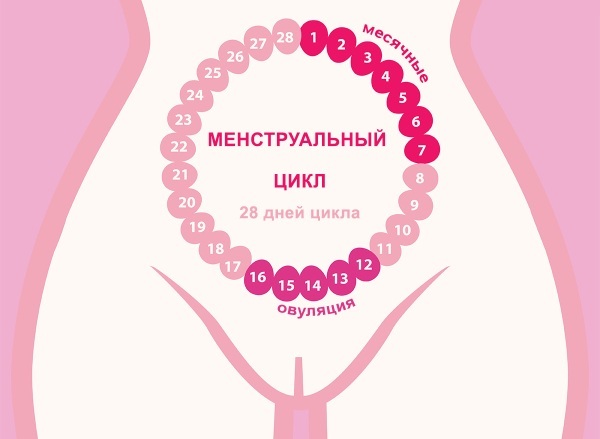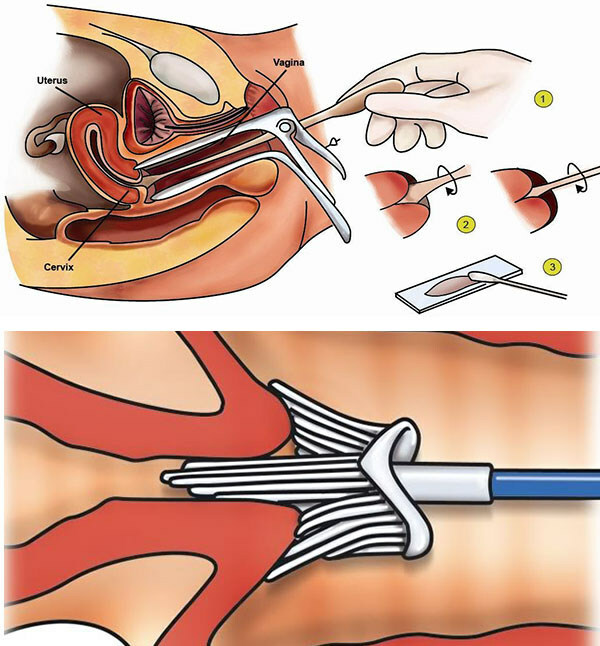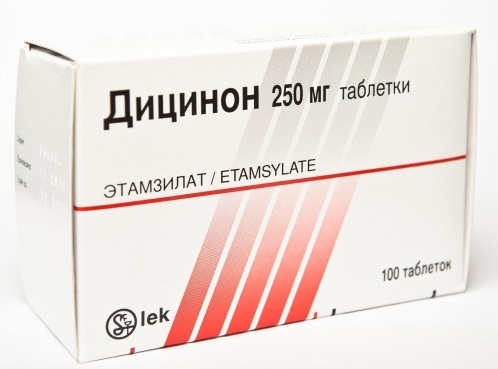Menstrual cycle is a monthly change in a woman's reproductive system that results in oocytes are produced in the uterus and conditions are created that are favorable for preparing it for pregnancy. The average cycle time is 28 days. If the cycle fits into the interval of 21-35 days, this is the norm.
Record content:
- 1 Phases
- 2 Norm
- 3 How to count correctly
- 4 Causes of deviations from the norm at the age of 30-40 years
- 5 Reasons for a decrease in the cycle
- 6 Diagnostic methods
- 7 Treatment of disorders
- 8 Possible complications
- 9 Period Cycle Videos
Phases
There are three phases in the menstrual cycle, following one after another in stages:
- The first, longest stage is follicular. Its duration may vary depending on the individual characteristics of each woman, but should not be more than 20 days.
With the beginning of this stage, the process of production of the female hormone estrogen starts. Under its influence, active growth of follicles occurs in the ovaries for 7 days. At first, there may be several follicles. When one of them reaches the desired size, it becomes dominant. Further, the main follicle will be used for the formation and maturation of the egg, the rest cease to exist.
When the level of estrogen reaches a high concentration, this serves as an impetus for the beginning of the production of another hormone - luteinizing. He will be responsible for preparing for future ovulation.
- The second, very significant phase is ovulation. Although its duration does not exceed a couple of days, it is it that represents the key stage in which the essence of the menstrual cycle is concentrated.
Under the influence of luteinizing hormone, the walls of the endometrium thicken and the necessary conditions are created for enhanced maturation of oocytes. After full maturation and readiness for fertilization, the egg leaves the follicle and enters the fallopian tube.

The ruptured follicular vesicle transforms into a corpus luteum. Now its main function is to generate progesterone, which is necessary to complete the process of fertilization of the egg and attach the embryo to the walls of the uterus.
After the start of the phase, fertilization can occur only within 48 hours, then the egg dies.
- The final stage is luteal. It is a consequence of ovulation. There are two possible options for the course of this phase, depending on whether fertilization has occurred or not.
Here the main role belongs to the corpus luteum:
- if fertilization has occurred, the corpus luteum begins to actively produce luteal hormone and progesterone, which support the ovum and nourish it until the placenta is formed;
- if fertilization does not occur, the corpus luteum stops developing and dies, the unfertilized egg is rejected from the prepared uterine membrane and leaves with it in the form of bleeding.
At the moment of the appearance of bleeding, the cycle ends at the same time and a new one begins, with which the whole process will be repeated step by step.
Norm
The menstrual cycle is established in adolescence with the onset of menarche (first menstruation). Menarche occurs at different ages depending on the degree of puberty, on average at 12.5 years. The interval between the first and second menstruation can be 20-60 days, and they will become regular only after 2-3 years.
The cycle of menstruation (the norm of days in women is an average of 28 days) allows deviations of about a week in the direction of increase or decrease. The duration of bleeding is on average 3-6 days. In general, the cycle is highly dependent on the physical and emotional state of the woman.
The main reasons leading to menstrual irregularities are:
- External negative factors: acclimatization, change of seasons, stress and excitement experienced, changes in diet, lack of sleep.
- The presence of diseases.
- The use of medications, including hormonal drugs, antidepressants, and drugs that affect the nervous system.
The scope of the norm is determined by the following parameters:
- regardless of the individual number of days of the cycle, it should always be regular, that is, it should always be approximately the same number of days;
- the duration of the cycle should not be less than 21 days and more than 36 days;
- the duration of bleeding should not be more than 7 days and less than 3 days.
How to count correctly
The cycle of menstruation (the norm of days in women is mostly stable) has a different duration. It is very important to calculate it correctly.
Monitoring the cycle will help you prepare in a timely manner for the onset of menstruation, plan a pregnancy, and detect symptoms that indicate health problems. For accurate cycle monitoring, it is recommended that you mark the start and end dates of your period on a calendar.
It is necessary to correctly calculate the duration of the cycle, starting from the first day of menstrual flow, ending on the last day before the next bleeding appears.
Causes of deviations from the norm at the age of 30-40 years
The cycle of menstruation, the norm of days in women of which is determined, can stop only with the onset of pregnancy or menopause.
Upon reaching the age of 30-35 years, the duration of the cycle is reduced. The reason is a decrease in the production of progesterone and estrogen, a decrease in the number of follicles, which shortens the duration of the second stage and the cycle as a whole.
By the age of 40, there is a gradual extinction of reproductive function. Insufficient hormone production further shortens the cycle, causing the ovarian function to diminish. The intervals between periods become longer, and the discharge is less abundant.
This period is characterized by the onset of premenopause. Lack of hormones leads to the onset of climacteric syndrome, which manifests itself in increased sweating, mood swings, weight gain, and increased heartbeat.
More often after 50 years, and sometimes already in 40-45 years, the onset of menopause and the cessation of menstruation are possible.
Reasons for a decrease in the cycle
Shortening the natural menstrual cycle means shortening the follicular phase, and not only shortening the cycle length. The nature and volume of the discharge also change. The bleeding becomes profuse and painful.
The reasons for such changes may be as follows:
- pregnancy;

- disorders of the processes of the endocrine system: pituitary tumors, hypogonadism, thyroid diseases;
- early ovarian depletion, accompanied by a decrease in estrogen production;
- abortion;
- stress, nervous and physical overload;
- mental illness;
- genital infections;
- drastic weight loss or obesity;
- intoxication;
- inflammatory diseases;
- ovarian pathology: polycystic disease, hyperfunction, atrophy, inflammation;
- anomalies in the structure of the genital organs;
- chronic diseases of the uterus and uterine cervix.
Diagnostic methods
The use of comprehensive diagnostic methods will help determine the cause of menstrual irregularities and prescribe effective treatment to eliminate failures.
The following symptoms may be cause for concern and referral to a gynecologist:
- absence of menstruation at 12-14 years old;
- menstruation is irregular;
- a sharp reduction in the cycle;
- very scant or very profuse discharge;
- the appearance of pains of varying degrees of intensity in the area of the ovaries, pubic zone, lower back;
- deterioration in general well-being during the bleeding period;
- bleeding between periods;
- vaginal discharge with an uncharacteristic consistency and an unpleasant odor.
The cycle of menstruation during the examination of each woman is considered on the basis of anamnesis data: the duration of menstruation in days, available and past diseases, lifestyle, working conditions, the presence of diseases in the next of kin, analysis of the correspondence of physique, height, weight norms.
To make the final diagnosis, the gynecologist conducts a complete examination of the patient, including:
- examination of the mammary glands - to obtain primary information about possible violations, because they are most susceptible to the effects of various hormones;
- examination by a gynecologist on a chair - to assess the characteristics of the development and condition of the genitals, the position of the uterus and ovaries;
-
taking a smear - for analysis to identify possible infections;

- clinical blood test - to determine the number of erythrocytes, leukocytes, platelets, going beyond the norm of which shows the presence of an inflammatory process in the body and the degree of anemia.
- study of the hormonal function of the ovaries and blood tests to the level of hormones - to obtain information about the nature of the menstrual cycle and the onset or non-occurrence of ovulation;
- Ultrasound - to identify formations of various kinds on the uterus and ovaries;
- colposcopy - to determine the symptoms of chronic inflammatory diseases, hormonal disorders, diseases of the genital organs;
- hysteroscopy - to study the structure of the uterus, identify polyps on the endometrium, pathologies and disorders;
- histology - to identify malignant cells;
- biopsy for women over 35 years old - for the study of the endometrium in order to exclude malignant tumors.
- hysteroscopy and laparoscopy - endoscopic methods to study the structure of the uterus and detect pathologies and disorders
Treatment of disorders
The cycle of menstruation (the norm of days for women is always individual) must be adjusted in case of failures. Sometimes, to eliminate the causes of the failure, it is enough to change your lifestyle, lose weight, give up bad habits and eat right.
Based on the diagnostics performed, the doctor prescribes treatment. Treatment tactics depend on the identified disease. It is not recommended to self-medicate, only experienced gynecologists-endocrinologists can prescribe effective and adequate treatment.
The methods of therapy (or surgical procedures) depend on the nature and origin of the identified problems:
1. Conservative treatment carried out when various pathologies are detected at an early stage with medication using the following drugs and methods:
- to relieve pain: analgesics and antispasmodics, the main active ingredient in which can be Analgin, Paracetamol, Ibuprofen, Drotaverin, Piroxicam, Ketolong, Metamizole sodium;
- with abundant discharge: hemostatic drugs, For example:
- Dicinon.

- Tranexam.
- Vikasol.
- Etamsilat.
- Ascorutin.
- Diphereline.
- upon detection of an inflammatory process: anti-inflammatory drugs, depending on the site of localization, or antibiotics;
- in case of disorders of the endocrine system: hormonal drugs such as: Mersilon, Marvelon, Regulon, Novinet, Diane-35, Logest, Femoden, Silest, Ovidon, Rigevidon, Non-Ovolon, Miniziston.
- vitamins;
- physiotherapy.
2. Surgical intervention it is necessary in the case when the drug treatment carried out did not bring the expected results, or when various kinds of pathologies are identified that require elimination.
The methods of exposure will be determined depending on the location and nature of the disease:
- scraping of the uterine cavity - with a broken cycle, heavy bleeding during menstruation or between them;
- enucleation and resection - when fibroids, polyps are detected;
- cryodestruction - with erosion of the cervix;
- radio wave surgery - to remove polyps, cervical erosion, warts and papillomas;
- removal of the uterus - with a large malignant tumor.
3. If no pathologies are detected during the diagnosis, it is effective to use traditional methods of treatment. Infusions and decoctions have a gentle effect on the body. The main thing is to choose the right plant depending on from the detected violation:
- You can relieve the spasm and soothe the pain by preparing the infusion of sweet clover as follows: 15 g of the plant is poured with two glasses of water, brought to a boil, the mixture is infused for 2 hours, filtered, taken 2-3 times a day at a dosage of 70-100 ml.
- To restore the cycle, an infusion of elecampane is taken, which is prepared in the same way.
- Lemon balm infusion will help relieve pain and calm down: 15 g of the plant is poured with a glass of boiling water, infused in a warm place for half an hour and filtered. It is taken 5-6 times a day at a dosage of 1-2 tbsp. l.
- A decoction of Potentilla can help to reduce pain: 5 g of the plant is poured with 200 ml of milk, the mixture is boiled for 5 minutes, then 5 g of golden mustache juice is added to it, the resulting broth is divided in half and taken in equal parts in the morning and in the evening.
- with a long absence of menstruation in case of inflammation or stress, take an infusion of chamomile, St. John's wort, celandine, sage, string or eucalyptus: 3 tbsp. l. herbs are placed in a thermos, filled with three glasses of boiling water, filtered after a couple of hours. It is taken 4 times a day at a dosage of 200-250 ml;

- with heavy bleeding, a decoction of herbal collection can help: 150 g each of chamomile and yarrow, 100 g of horsetail, 50 g of shepherd's handbag, lungwort and stomach, 20 g of mountaineer, and 200 ml water. Taken before bed. An infusion made from herbal collection is also recommended: 1 tbsp. l. yarrow, 1 tsp. l. oak bark and shepherd's handbag, filled with 500 ml of boiling water. It is kept for half an hour, filtered and taken in 250 ml in the morning and in the evening.
Possible complications
In case of any irregularities during the menstrual cycle, you must immediately contact a specialist who can understand the reasons, diagnose and treat.
In no case should you ignore the symptoms while self-medicating, otherwise complications and rather dangerous consequences may occur, which will be difficult to eliminate:
- the occurrence of premenstrual syndrome;
- if menstruation is too frequent and accompanied by profuse discharge, this will lead to severe fatigue, fatigue, disability, vitality;
- impossibility of conceiving and carrying a child;
- genital infections that have not undergone timely treatment can provoke the development of tumors and carry a great danger to health;
- constantly changing hormonal background can cause endocrine problems;
- breast cancer, ovarian cancer;
- mastopathy;
- anemia;
- malignant tumors of the uterine mucosa;
- ovarian dysfunction;
- overgrowth of the endometrium;
- the appearance of polyps;
- myoma.
Thus, the monthly cycle is different for each woman. The normal duration of menstruation can fluctuate in a fairly large range - from 21 to 36 days. The main thing to control is the regularity of the cycle.
Article design: Vladimir the Great
Period Cycle Videos
How long is the normal cycle of menstruation:



